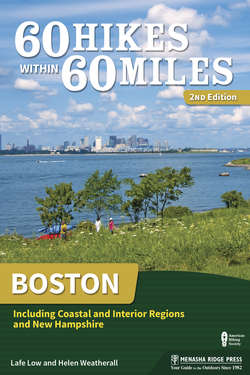Читать книгу 60 Hikes Within 60 Miles: Boston - Lafe Low - Страница 35
На сайте Литреса книга снята с продажи.
Оглавление9 WORLD’S END
DISTANCE & CONFIGURATION: 3.8-mile double loop
DIFFICULTY: Easy
SCENERY: Spectacular views of the Boston skyline, Hingham Harbor, and the Weir River
EXPOSURE: Partially shaded most of the way, except for parts of the carriage road and the causeway linking the twin drumlins of World’s End
TRAFFIC: Trails are popular but never crowded
TRAIL SURFACE: Packed dirt, mowed grassland, gravel
HIKING TIME: 1.3 hours
ELEVATION: 140' at trailhead, no significant gain
SEASON: Year-round
DRIVING DISTANCE FROM BOSTON COMMON: 15 miles
ACCESS: Sunrise–sunset; free for members of The Trustees of Reservations and children under age 12, $6 for nonmembers. World’s End is managed by The Trustees of Reservations but is also considered part of the Boston Harbor Islands National Park.
MAPS: Available in office at entrance or at tinyurl.com/worldsendmap
WHEELCHAIR ACCESS: Much of World’s End is accessible by wheelchair, but the Rocky Neck area is not.
FACILITIES: Well-maintained outhouses near parking lot, picnic tables on a hill beside entrance
CONTACT: The Trustees of Reservations, thetrustees.org/places-to-visit, 617-542-7696
LOCATION: Martin’s Lane, Hingham, MA
COMMENTS: The Trustees of Reservations organizes occasional special events, such as evening owl watches. Horseback riding is allowed; the annual permit costs $100. Leashed dogs are welcome.
The scenery at World’s End is breathtakingly beautiful.
EXPLORE A SCENIC PENINSULA, following a trail along the outer rim. The landscaping touches of Frederick Law Olmsted are still apparent, as are signs of the peninsula’s agricultural past.
DESCRIPTION
It’s a good thing the trail surface is primarily hard packed and fairly smooth throughout World’s End because your attention will be captivated by the scenery. The open fields, sweeping hillside, and statuesque trees lining much of the trail are impressive. It feels a bit like A. A. Milne’s Hundred Acre Wood combined with Treasure Island.
The trails are also well-defined and easy to follow. While there are several overlapping loops that all beg exploration, the trail specified here begins at the northeast end of the upper parking lot. This path, the width of a carriage, heads directly into an increasingly dense forest of oak and pine. While most of the trails passing through World’s End are wider carriage roads, these trails are more like true hiking trails. Down a rocky slope to the left, you will catch a glimpse of a marshy bog and an open meadow. Farther along on the right, the trail opens to a marshy shore and a waterway called Porter’s Cove.
The path bends left after the water view and meets a trail splitting to the right. Take this narrower trail to the right and, looking through the eastern-side underbrush, you will see waves lapping at the rocky coast. On the left, pass a freshwater bog populated by ducks. Another fork and a small pond lie just beyond. Stay right, keeping with the water.
There’s never too much elevation gain on these trails. As you come around to face north, you get a clear view of the Weir River and the town of Hull on the opposite bank. Looking west, you will see the great hourglass-shaped peninsula of World’s End stretching toward Boston. You may also see a smattering of eider ducks and seagulls populating the water.
The trail comes back around, heading southeast as it reaches the base of Rocky Neck. At each of three forks, bear right to head south. Dipping through a cedar thicket, the trail soon opens to meadowland. Leave the woods behind and walk uphill to rejoin the carriage road that forms the primary loop around World’s End. Stepping onto this level, gravel path, head north (right), keeping the Weir River over your right shoulder. The carriage path here is frequently punctuated with majestic ash trees.
The fields at World’s End are regularly mowed to keep them level. Majestic elm trees once dominated the landscape, but most were lost to Dutch Elm disease decades ago. Ash trees now stand in their place. Raptors, bluebirds, and bobolinks fill the forest. Follow the carriage road as it eases downhill around the right of Planter’s Hill and arrives at sea level. The trail here is still firm, hard-packed gravel. Ahead, look for the glacial isthmus linking Planter’s Hill to the northern tip of World’s End. This spit of gravel and ground shells serves as a causeway to the outer peninsula. On a clear day, you can catch dramatic glimpses of the Boston skyline to the northwest.
Cross over the causeway and follow the carriage road uphill, bearing right. Continuing north, the road soon reaches a split. Follow the straighter path, which takes you into what’s referred to as the Valley. Shortly you reach another junction. Turn sharply right and follow the trail as it circles the land counterclockwise. The road rises out of the dark woods of the Valley to lead back to a domed meadow. From here you’ll see the waterfront homes of Hull.
